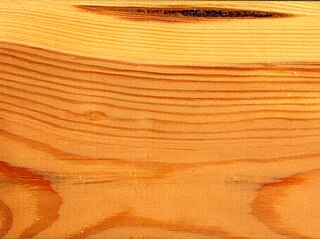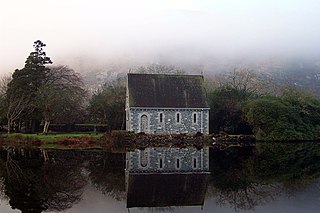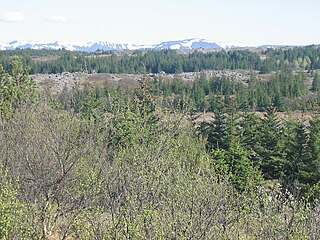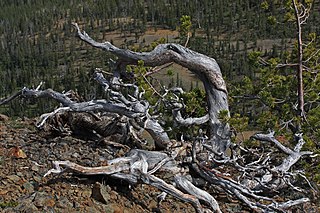
Taiga, generally referred to in North America as boreal forest or snow forest, is a biome characterized by coniferous forests consisting mostly of pines, spruces, and larches.

A spruce is a tree of the genus Picea, a genus of about 35 species of coniferous evergreen trees in the family Pinaceae, found in the northern temperate and boreal (taiga) regions of the Earth. Picea is the sole genus in the subfamily Piceoideae. Spruces are large trees, from about 20–60 m tall when mature, and have whorled branches and conical form. They can be distinguished from other members of the pine family by their needles (leaves), which are four-sided and attached singly to small persistent peg-like structures on the branches, and by their cones, which hang downwards after they are pollinated. The needles are shed when 4–10 years old, leaving the branches rough with the retained pegs. In other similar genera, the branches are fairly smooth.

Softwood is wood from gymnosperm trees such as conifers, as well as Amborella. The term is opposed to hardwood, which is the wood from angiosperm trees.

Kielder Forest is a large forestry plantation in Northumberland, England, surrounding Kielder village and the Kielder Water reservoir. It is the largest man-made woodland in England with three-quarters of its 250 square miles (650 km2) covered by forest. The majority of the forest lies within the Border Forest Park, with the southern tip known as Wark Forest lying within Northumberland National Park.

Picea sitchensis, the Sitka spruce, is a large, coniferous, evergreen tree growing to almost 100 m (330 ft) tall, with a trunk diameter at breast height that can exceed 5 m (16 ft). It is by far the largest species of spruce and the fifth-largest conifer in the world ; and the third-tallest conifer species. The Sitka spruce is one of the few species documented to exceed 300 ft (90 m) in height. Its name is derived from the community of Sitka in southeast Alaska, where it is prevalent. Its range hugs the western coast of Canada and the US, continuing south into northernmost California.

Gougane Barra is a settlement, west of Macroom in County Cork, Ireland.

Picea glauca, the white spruce, is a species of spruce native to the northern temperate and boreal forests in North America. Picea glauca was originally native from central Alaska all through the east, across southern/central Canada to the Avalon Peninsula in Newfoundland. It now has become naturalized southward into the far northern United States border states like Montana, Minnesota, Wisconsin, Michigan, Vermont, New Hampshire and Maine; there is also an isolated population in the Black Hills of South Dakota and Wyoming. It is also known as Canadian spruce, skunk spruce, cat spruce, Black Hills spruce, western white spruce, Alberta white spruce, and Porsild spruce.

The blue spruce, green spruce, white spruce, Colorado spruce, or Colorado blue spruce, with the Latin (scientific) name Picea pungens, is a species of spruce tree. It is native to North America, and is found in growing zones 1 through 7. Its natural range extends from northern New Mexico through Colorado and Utah to Wyoming and into Alberta and British Columbia, but it has been widely introduced elsewhere and is used as an ornamental tree in many places far beyond its native range. The blue spruce has blue-green coloured needles and is a coniferous tree.

Heiðmörk was proclaimed a municipal conservation area of Reykjavík in 1950. It is located southeast of Elliðavatn, Iceland, and is about 6 miles (9.7 km) from the city of Reykjavík. Its name is derived from its namesake in Norway, Hedmark, an area with deep forests.

Krummholz or krumholtz — also called knieholz — is a type of stunted, deformed vegetation encountered in the subarctic and subalpine tree line landscapes, shaped by continual exposure to fierce, freezing winds. Under these conditions, trees can only survive where they are sheltered by rock formations or snow cover. As the lower portion of these trees continues to grow, the coverage becomes extremely dense near the ground. In Newfoundland and Labrador, the formation is known as tuckamore. Krummholz trees are also found on beaches such as the Oregon coast, where trees can become much taller than their subalpine cousins.
The plant pathogenic fungus Leucostoma kunzei is the causal agent of Leucostoma canker a disease of spruce trees found in the Northern Hemisphere, predominantly on Norway spruce and Colorado blue spruce. This disease is one of the most common and detrimental stem diseases of Picea species in the northeastern United States, yet it also affects other coniferous species. Rarely does it kill its host tree; however, the disease does disfigure by killing host branches and causing resin exudation from perennial lesions on branches or trunks.

Glengarra Wood is a mixed woodland in Ireland located 15 kilometres (9.3 mi) southwest of Cahir, Co. Tipperary off the M8 motorway and R639 road. Approximately 570 hectares in extent, it is situated on Old Red Sandstone on the southern slopes of the Galtee Mountains. It is mainly a coniferous forest with Sitka Spruce being the main species. Other conifer species present include Scots Pine, Japanese Larch, Douglas Fir, Norway Spruce, Western Hemlock and Western Red Cedar. The area also contains approximately 50 hectares of native Oak, Birch and Alder. Animals present include fallow deer, foxes, badgers, hares and red squirrels. Birds include pheasants, hawks, kestrels, ravens, herons and many song birds.

Faskally Forest, also known as Faskally Woods, is a wooded area in the historic county of Perthshire, Scotland. It is among the mixed woodlands of Perthshire, and is well known for its radiant colours during the autumn. It is one of the early forest lands of Perthshire Big Tree County. Originally a "model woodland" developed in the 19th century with a resort owned by Archibald Edward Butter. In 1953, Faskally was acquired by the Forestry Commission of Scotland to set up a school for training young foresters.

Drumkeeragh Forest is a mixed coniferous forest located on the lower slopes of Slieve Croob, near Ballynahinch, Northern Ireland. It is used for commercial felling and is managed by the Forest Service Northern Ireland.

The Alps conifer and mixed forests is a temperate broadleaf and mixed forests ecoregion in central Europe. It extends along the Alps mountains through portions of France, Italy, Switzerland, Germany, Liechtenstein, Austria, and Slovenia. The ecoregion extends from the lower slopes of the Alps to its peaks, which include Mont Blanc, at 4,809 m (15,778 ft) the highest peak in the Alps.
















